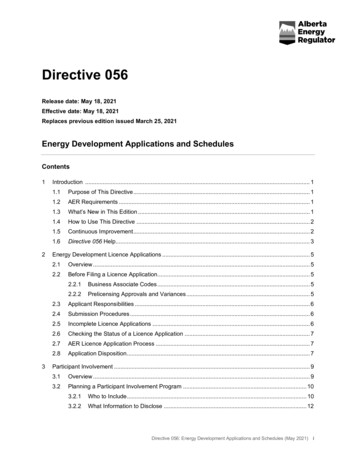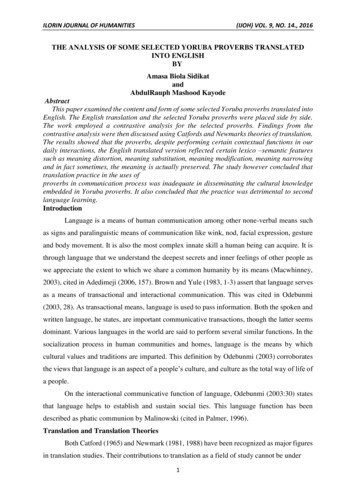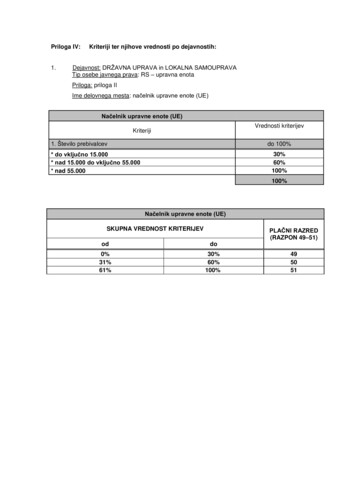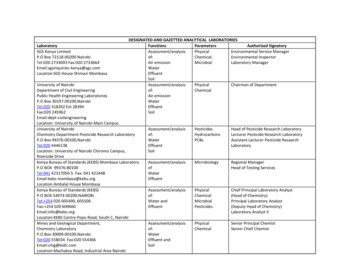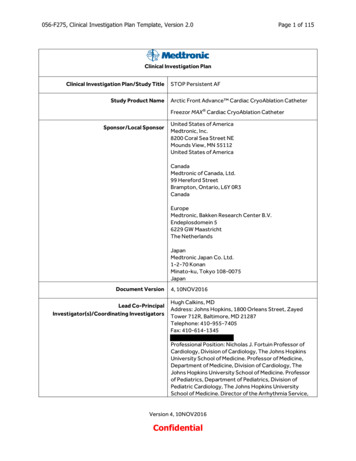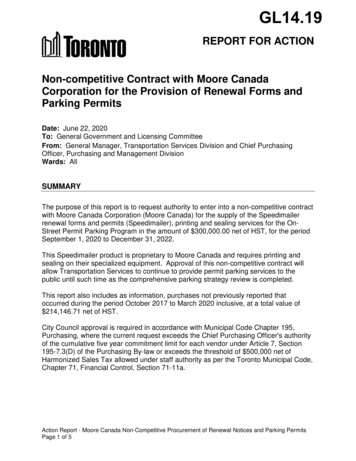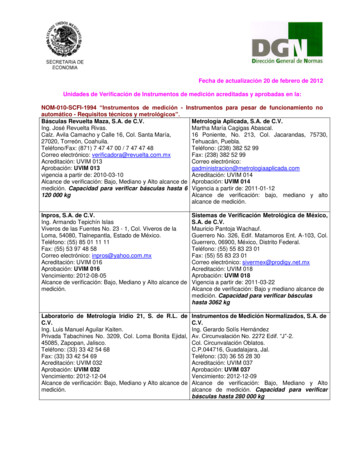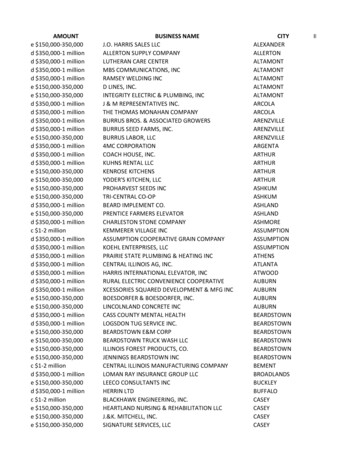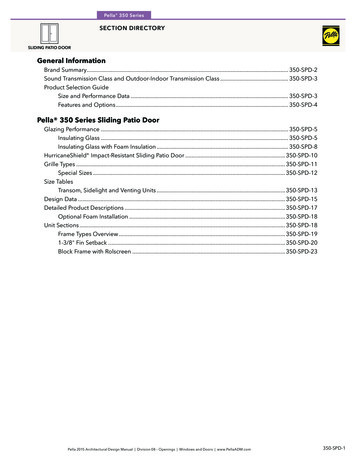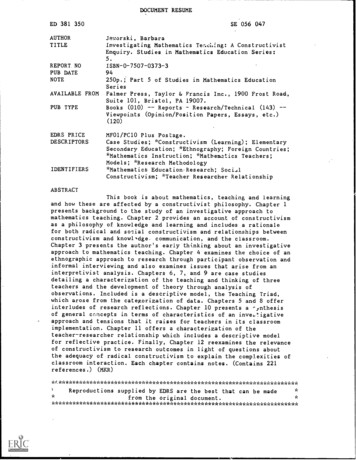
Transcription
DOCUMENT RESUMEED 381 350SE 056 047AUTHORTITLEJaworski, BarbaraInvestigating Mathematics Ter.ching: A ConstructivistEnquiry. Studies in Mathematics Education Series:5.REPORT. NOPUB DATENOTEAVAILABLE FROMPUB TYPEISBN-0-7507-0373-394250p.;. Part 5 of Studies in Mathematics EducationSeriesFalmer Press, Taylor & Francis Inc., 1900 Frost Road,Suite 101, Bristol, PA 19007.Books (010)ReportsResearch/Technical (143)Viewpoints (Opinion/Position Papers, Essays, etc.)(120)EDRS PRICEDESCRIPTORSIDENTIFIERSMF01/PC10 Plus Postage.Case Studies; *Constructivism (Learning); ElementarySecondary Education; *Ethnography; Foreign Countries;*Mathematics Instruction; *Mathematics Teachers;Models; *Research Methodology*Mathematics EducationResearch; Soci.,1Constructivism; *Teacher Researcher RelationshipABSTRACTThis book is about mathematics, teaching and learningand how these are affected by a constructivist philosophy. Chapter 1presents background to the study of an investigative approach tomathematics teaching. Chapter 2 provides an account of constructivismas a philosophy of knowledge and learning and includes a rationalefor both radical and social constructivism and relationships betweenconstructivism and knowl-.dge communication, and the classroom.Chapter 3 presents the author's early thinking about an investigativeapproach to mathematics teaching. Chapter 4 examines the choice of anethnographic approach to research through participant observation andinformal interviewing and also examines issues that arise from aninterpretivist analysis. Chapters 6, 7, and 9 are case studiesdetailing a characterization of the teaching and thinking of threeteachers and the development of theory through analysis ofobservations. Included is a descriptive model, the Teaching Triad,which arose from the categorization of data. Chapters 5 and 8 offerinterludes of research reflections. Chapter 10 presents a -ynthesisof general cnncepts in terms of characteristics of an inve.,!*igativeapproach and tensions that it raises for teachers in its classroomimplementation. Chapter 11 offers a characterization of theteacher-researcher relationship which includes a descriptive modelfor reflective practice. Finally, Chapter 12 reexamines the relevanceof constructivism to research outcomes in light of questions aboutthe adequacy of radical constructivism to explain the complexities ofclassroom interaction. Each chapter contains notes. (Contains ctions supplied by EDRS are the best that can be made*from the original ******************************
ItintinesteM00TeachingA Constructivist EnquiryBarbara JaworskiUDEPARTMENT OF EDUCATOROffice ot Educations, Researchand Improvement' PERMISSION TO REPRODUCE THISMATERIAL HAS BEEN GRANTED BYEDUCATIONAL RESOURCES INFORMATIONCENTER (ERIC)AD!This document has been reproduced aseceived 'nom the person or organizationoriginating itO Min , changes have boon muds to amprovorINOOtaction cMYPoints I sew or opinions stated in the doctmint do not nocesaaMy representOERI poirtion Of pOliCYtou.JTO THE EDUCATIONAL RESOURCESINFORMATION CENTER (ERIC)"&katrti; The Falmer Press2BEST CCPY AVAILABLE
Investigating Mathematics Teaching
Studies in I Aathematics Education SeriesSeries EditorPaul ErnestSchool of EducationUniversity of ExeterExeter1The Philosophy of Mathematics EducationPaul Ernest2Understanding in MathematicsAnna Sierpinska3Mathematics, Education and PhilosophyEdited by Paul Ernest4Constructing Mathematical Knowledge: Epistemology and MathematicsEdited by Paul Ernest5Investigating Mathematics Teaching: A Constructivist EnquiryBarbara Jaworski6Radical Constructivism: A Way of Knowing and LearningErnst von Glasersfeld
Studies in Mathematics Education Series: 5Investigating MathematicsTeaching:A Constructivist EnquiryBarbara JaworskiThe Falmer Press(A member of the Taylor & Francis Group)London Washington, D.C.
UKUSAThe Falmer Press, 4 John Street, London WC1N 2ETThe Falmer Press, Taylot & Francis Inc., 1900 Frost Road, Suite 101,Bristol, PA 190070 B. Jaworski, 1994All rights resetved. No part of this publication may be reproduced, stored in aretrieval system, or transmitted in any form or by any means, electronic, mechanical, phc:ocopying, recording or otherwise, without permission in writing fromthe Publisher.First published in 1994A catalogue record for this book is available from theBritish LibraryLibrary of Congress Cataloging-in-Publication Data areavailable on requestISBN 0 7507 0373 3 casedJacket design by Caroline ArcherTypeset in 9.5/11 pt Betnbo byGraphicraft Typesetters Ltd., Hong Kong.Printed in Great Britain by Burgess Science Press, Basingstoke on paperwhich has a specified pH value on final paper manufacture of not less than7.5 and is therefore 'acid free'.
TcJohnand to my parentsGladys and Gilbert WhitlowTh
ContentsDedicationPreface by Series EditorPrefaceAcknowledgmentsEpigraphChapter 1 An Investigative Approach: Why and How?Personally and HistoricallyThe Origin of InvestigationsThe Purposes of InvestigationsThe Place of Investigational Work in the Mathematics CurriculumClassroom ApproachesAn Investigative Approach to Mathematics TeachingChapter 2 Constructivism: A Philosophy of Knowledgeand LearningIntroductionRadical ConstructivismRadical Constructivism and KnowledgeConstructivism, Meaning and CommunicationSocial ConstructivismConstructivism and the ClassroomPiaget and VygotskyConsequences for TeachingThe Social and Cultural EnvironmentChallenges to ConstructivismThe Learning ParadoxConstructivism and PedagogyConstructivism and OntologyChapter 3 Working with Two Teachers: Darning the StudyTentative BeginningsAn Outline of my First Phase of ResearchThe Early ObservationsEmergence of Field NotesObserving my Own 93134363637384144vii
ContentsParticipant Observation and AnalysisA Lesson on TessellationsMy Immediate Account of Reflections on the Pair ofTessellations LessonsLater Reflections on this AccountConclusionChapter 4 The Research ProcessIntroductionA Very Brief OverviewThe Choice of an Ethnographic ApproachFocus and Emphasis of the ResearcherData CollectionInterpretive EnquiryData AnalysisSignificanceThe Place of Theory in Ethnographic ResearchValidation and RigourA Constructivist PerspectiveChapter 5 Interlude 1: From Phase I to Phase 2Theory Validation to Theory ConstructionThe 'Fit' with Radical ConstructivismRelating Constructivism to Teacher developmentImplications for Phase 2Chapter 6 Clare: Origins of the Teaching TriadBackgroundThe School and the Mathematics DepartmentAnalysis of Clare's Autumn-term LessonsManagement of LearningCategorization of DataIdentifying Management of LearningFurther Manifestations of Management of LearningSensitivity to StudentsMathematical ChallengeAn Investigative Approach?Analysis of the Spring-term LessonsThe Packaging LessonThe Lines-crossing LessonTeacher's and Students' viewsCharacterizing Clare's TeachingChapter 7 Mike: Significant Episodes and the Teaching TriadBackgroundThe Teaching Triad Related to Mike's TeachingManagement of LearningSensitivity to StudentsMathematical ChallengeTeacher's and Students' 3117123126
ContentsTensions for the TeacherBalance: Management and Control, Sensitivity and ChallengeChapter 8 Interlude 2: From Phase 2 to Phase 3Teacher and Researcher AwarenessRecognition of an Issue: The Teacher's DilemmaThe Researcher's DilemmaSignificanceImplications for Phase 3Chapter 9 Ben: Affirming the Teaching TriadBackgroundThe Teaching TriadThe 'Moving Squares' LessonCreating an Environment for Thinking and InvolvementThe Lesson OpeningWorking on the TaskWhy?An Investigative LessonDidactic Versus Investigative TeachingThe Vectors LessonThe Lesson OpeningWorking on the TaskA Didactic LessonWhy?Theoretical ConsiderationsChapter 10 Investigative Mathematics Teaching: Characteristicsand TensionsCharacteristics of Classrooms ObservedTeaching Acts: Some Common ThemesCharacterizing the Teaching Role: Teaching OutcomesEstablishing Mathematical MeaningEngendering Mutual Trust and RespectEncouraging Responsibility for Own LearningTensionsThe Teacher's DilemmaThe Didactic-Constructivist TensionThe Didactic TensionThe Double DialecticA Counter-exampleChapter 11 Reflection and DevelopmentThinking and ReflectionSome Starting PointsThe Teacher-Researcher RelationshipStage 1: ReflectingStage 2: Accounting forStage 3: Critical AnalysisDevelopment of Teaching: Teaching Knowledge andTeaching WisdomResearcher PerceptionsReflecting on the Conceptual ModelThe Epistemology of 8179180181182186188190192194196197198199ix10
1ContentsSupporting the Reflective TeacherMy Own Development as a Reflective PractitionerReflective Practice Is 'Critical' and Demands 'Action'Investigative TeachingChapter 12 EpilogueTheory and PracticeThe Problematic Position of Classroom KnowledgeConstructivism and its Place in this ResearchIndividual and Social DimensionsFrom Individual to Intersubjective KnowledgeSocio-cultural PerspectivesAn Interactionist PerspectiveSocial Constructivism in this StudyThe Value of this Study for Teachers and Other 208208210211212213215226xt
Preface by Series EditorM".thematics education is now established worldwide as a major area of study,with numerous dedicated journals and conferences serving national and international communities of scholars. Research in mathematics education is also becoming more theoretically orientated. Vigorous new perspectives are pervading itfrom disciplines and fields as diverse as psychology, philosophy, logic, sociology,anthropology. history, feminism, cognitive science, semiotics, hermeneutics, poststructuralism and post-modernism. The series Studies in Mathematic: Educationconsists of research contributions to the field based on disciplined perspectives thatlink theory with practice. It is founded on the philosophy that theory is thepractitioner's most powerful tool in understanding and changing practice. Whetherthe practice is mathematics teaching, teacher education, or educational research,the series intends to offer new perspectives to assist in clarifying and posingproblems and to stimulate debate. The series Studies in Mathematics Education willencourage the development and dissemination of theoretical perspectives in mathematics education as well as their critical scrutiny. It aims to have a major impacton the deveiopment of mathematics education as a field of study into the twentyfirst century.The present volume is the fifth in the series. In it Barbara Jaworski describesher personal enquiry into mathematics teaching. It addresses a number of questions that are central to research in mathematics education today: What does aninvestigational or enquiry classroom look like? What does constructivism mean inpractice? What impa t does researching a teacher's classroom have on the teacher'sbeliefs and practices? How are theory, research and reflective practice interconnected? How does the researcher grow and change through engaging in classroomresearch? This last question indicates the particular strength of Barbara Jaworski'saccount. She attempts to honestly but critically chart her own developing ideas asshe undertakes a several-year itig enquiry into mathematics teaching. She succeeds admirably in giving a fi m-sollal account of her developing conceptions, herconjectures, thoughts and reflections, as they develop and complexify. She alsoreveals how she grapples with and appropriates and develops theory over thecourse of her enquiry. with a candour that few of us would dare to emulate inpublic.Teachers writing their dissertations often want to follow the chronologyof their research in their accounts, thus telling a personal truth but at cost to thelogic of justification of their overall inquiry. Barbara accounts for her researchgenetically and biographically, but succeeds in simultaneously reconstructing theXi
Preface by Series Editordevelopment of her ideas and in giving a rigorous, critical and reflective accountof the research. This fits with a current trend in educational and feminist researchin the interpretative paradigm towards narrative, biography, and research accountsin which the presence of the researcher is centrally acknowledged. Not many suchaccounts are yet available, especially in the field of mathematics education. I predictthat this book will be very influential in stimulating work in this orientation, andwill be much cited by researchers wishing to follow a similar path. It also makesa point which is lost in the sometimes hot debates about constructivism. Namelythat there is no essential and circumscribed fixed nature to constructivism. It is asBarbara Jaworski shows, an evolving cluster of ideas and orientations which becomes constructed and elaborated as the researcher unpacks and creates it in herunique social contexts and trajectories of enquiry.Paul ErnestUniversity of ExeterMay 1994xii
PrefaceThis book is about mathematics, teaching and learning and how these are affectedby a constructivis, philosophy. It charts my own exploration of what might beinvolved in an investigative approach to mathematics teaching. This was a concept whichhad started to form in my mind while I was still a classroom teacher, and whichmy move into university education offered me a chance to explore more fully.My introduction to constructivism was a timely experience, and much of my exploration involved rationalizing classroom issues with this theoretical perspective.The research involved a qualitative study of mathematics teaching throughclose scrutiny of the practice of a small number of mathematics teachers. It'spurpose was to try to characterize the nature of an investigative approach tomathematics teaching. It involved many hours of cbservation in classrooms andof conversations with teachers and pupils. An essential part of the study was aclarification of what an investigative approach might mean in terms of teachingpractices and issues for teachers. It led to a recognition of issues in the development of teaching, and also to a critiquing of the research process and the involvement of the researcher, myself.In 1994, as I write this, it is hard to perceive the person I was in 1985 whenthe research began. Indeed it is only possible to look back through the lens of mycurrent knowledge based on experience which includes the last nine years as wellas all those before that. As I reflect now on that research, on the questions Iaddressed about teaching and learning, and about the research process itself, Irecognize that it involved a deep learning experience for me, of which my observations of, and interactions with, the other teachers were merely a part, albeit avery important part.In 1991 I gained my PhD from the Open University with a thesis which tookthe form of a research biography. In it I tried to set out in a style acceptable tothe examiners the theory, research and conclusions of five year's wok and thinking. It proved impossible to do this from any position other than that of thecentrality of the researcher to the research. I saw the research then as being ethnographic, or interpretivist, but I realize now that an alternative term is constructivist.I took constructivism as the central tenet of my theoretical position on teachingand learning, and tentatively recognized its internal consistency with the way myresearch evolved. There are some problems in labelling the research itself as'constructivist' just as there arc in talking about constructivist teaching. Ways inwhich constructivism as a philosophy can be seen to influence research and teachingare a major focus of the book.13
PrefaceCriticisms of constructivist-based research centre around problems in justifying research conclusions, in judgments involving the validity of the research. Ifollow a position that a researcher needs to embed the research in its total situatedcontext, and that this includes his or her own experiences and thinking. In beingguided by constructivism, I see myself not so much as being drawn into anincreasingly relativistic spiral, as being challenged constantlyto be critical of my conclusions and their bases, andto relate these to my thinking and analysis and its interactions with otherthinkerseither personally, or indirectly through their written accounts.In this book I have tried where possible to include details of my thinking atall stages of the research, as encapsulated in my writings at the time, and also toportray the theoretical perspectives which prevailed when I wrote my thesis.However, I recognize also the need to set these into the context of my currentthinking. I therefore offer this account as a synthesis of all these influences.The structure of the bookI have tried to present an account which is loosely chronological, in that it followsthe development of thinking through three successive phases of research. Eachphase involved a study of teaching over a period of six to nine months. Analysistook place both during and between the phases.Chapter 1 presents a background to the study of an investigative approach tomathematics teaching. This includes both my own perspective of investigationalwork and its origins, and wider perspectives in the development of mathematicsteaching.Chapter 2 provides an account of constructivism as a philosophy of knowledge and learning, particularly as it relates to mathematics education and necessarily from my own perspective. This includes a rationale for both radical and socialconstructivism, and relationships between constructivism and knowledge, communication, and the classroom. It also addresses some of the challenges toconstructivism which seem relevant to mathematics education.Chapter 3 presents some of the very early stages of my research along withthe thinking which this involved at the time and the issues which arose. It encompasses early thinking about an investigative approach and also about research whichmight elucidate such an approach. It tries to capture the methodological beginnings of the research project.In Chapter 4, I provide a rationale for the research methods employed in mymain study for which the first phase of research, reported in Chapter 3, was apilot. This examines the choice of an ethnographic approach to the research throughparticipant observation and informal interviewing. It examines issues which arisefrom an interpretivist analysis, and the place of theory in the research. It justifiesthe use of research biography as a reflexive accounting process which contributesto the validatory processes in the research.Chapters 6, 7 and 9 are case studies taken from the second and third phasesof the research which formed my main study. In this I present in some detail acharacterization of the teaching and thinking of three teachers, Clare, Mike andxiv
PrefaceBen, and the development of theory through analysis of my observations. Incategorization arising from the teaching of Clare, in Phase II, a descriptive modelemerged which became known as the Teaching Triad. This was subsequentlytested in Phase III, through the teaching of Ben, and again through a re-analysisof the teaching of Mike from Phase II.Chapters 5 and 8, interludes between the above chapters, offer research reflections relevant to the three phases of research. These link observations with mlown development of thinking, and therefore analysis, across the phases and particular teachers.In Chapter 10 I have tried to synthesize general concepts which have arisenfrom my analyses. both in terms of characteristics of an investigative approachand tensions which it raises for teachers in its classroom implementation.A most significant outcome of the research was a recognition of the implications of reflective practice for development of both teaching gad research. Therelationship between teacher and researcher was centrz to this recognition. Chapter 11 offers a characterLation of the teacher researcher relationship which includes a descriptive model for reflective practice.Chapter 12 returns to the theoretical basis of the research. I re-ea amine therelevance of constructivism to the research outcomes in the light of questionsabout the adequacy of radical constructivism to explain the complexities of classroom interaction. The chapter considers theoretical perspectives of social andcultural dimensions in learning and teaching and their relation to cognitive processes. It justifies my own theoretical position in presenting the research from asocial constructivist perspective.lust one point finally: My classroom observations took place just before theintroduction of the National Curriculum in mathematics. Thus, the teachers studiedwere not at this stage influenced by pressures of the NC and its testing. It has notbeen possible to revisit these teachers to explore what differences this has made totheir classroom practice.Barbara JaworskiMay 1994xv
AcknowledgmentsThis study owes a great deal to the teachers who were subjects of my classroomresearch. To Felicity, Jane, Clare, Mike, Ben and Simon, my very sincere thanksfor their interest and cooperation, and for the time whicit they so generously gave.Many of my colleagues have played an important part in terms of supportand encouragement and extreme tolerance. I have appreciated their willingness tolisten, to talk over ideas and to offer their perceptions. It would be impossible tolist everyone who has been of help, but I should like particularly to thank PeterGates, Sheila Hirst, David Pimtn, Stephanie Prestage, Brian Tuck and AnneWatson.I owe special gratitude to John Mason, Christine Shiu, and John Jaworski fortheir exceptional support and inspiration, and to Paul Ernest, the series editor, forhis critical appreciation.Finally I must acknowledge Princess Borris-in-Ossory and Frankincense for theircontribution to this work. They were mainly responsible for my not getting coldfeet during its many drafts.Barbara JaworskiMay 1994xvi
In the halls of memory we bear the images of things once perceived, asmemorials which we can contemplate mentally, and can speak of witha good conscience and without lying. But these memorials belong to usprivately. If anyone hears me speak of them, provided he has seen themhimself, he does not learn from my words, but recognises the truth ofwhat I say by the images which he has in his own memory. But if he hasnot had these sensations, obviously he believes my words rather thanlearns from them When we have to do with things which we behold inthe mind . . . we speak of things which we look upon directly in theinner light of truth . . .(St. Augustine, De Magistro, 4th century AD*). . must . . . look upon human life as chiefly a vast interpretive process in which people, singly and collectively, guide themselves by definingthe objects, events and situations which they encounter . . . Any schemedesigned to analyse human group life in its general character has to fit thisWe .process of interpretation.(Blumer, 1956, p. 686)* Augustine: Earlier writings. H.S. Burleigh (Ed), Westminster Press. p. 96.xvii4
Chapter 1An Investigative Approach:Why and How?As a classroom teacher of mathematics in English secondary comprehensive schools in the 1970s and early 1980s, I struggled with ways of helpingmy students to learn mathematics. I enjoyed doing mathematics myself,and I wanted students to have the pleasure that I had in being successfulwith mathematical problems. I experienced the introduction and implementation of syllabuses involving the 'new' mathematics. This gave mea lot of pleasure as I enjoyed working with sets and functions, withBoolean algebra, with matrices, with transformation geometry. Some ofmy students enjoyed this too, but the vast majority were, I came torealize, as mystified with the 'new' maths as with any of the more traditional topics on the syllabus.Personally and HistoricallyTeaching mathematics was difficult, because students found learning mathematicsdifficult. I started to question what it actually meant to learn mathematics. Explanations or exposition seemed very limited in terms of their effect on students'learning, so I found myself seeking alternative approaches to teaching mathematical topics, especially for students who were not inclined to like or be successfulwith mathematics.I gained considerable personal enjoyment from puzzles, problems and mathematical investigations such as those offered by Martin Gardner (1965, for example) and occasionally used some of these, or modifications of them with students.This was 'extra' to my teaching of the mathematics syllabus, and I suspect, onreflection, very much in the mode of the teacher described by Stephen Lerman(1989b, p. 73) who 'went around the classroom offering advice such as 'no, notthat way, it won't lead anywhere, try this'. According to Lerman 'them !tad beenno opportunity for the teacher to discuss or examine . . how [an investigation]might differ from "normal" mathematics'. In my earlier teaching it was not somuch lack of opportunity to examine this issue as a lack of awareness on my partof how mathematical investigations might be linked to the mathematics or hesyllabus.In 1980, dissatisfaction with the mathematical achievement of many students,and a new post as head of a school mathematics department, made me start to119
I ivestigating Mathematics Teachinglook more seriously at the idea of mathematical investigation permeating 'normal'mathematics teaching. A number of my colleagues, who enjoyed getting involvedin mathematical problems, were willing to start to think, at least in theory, aboutwhat an investigative approach to mathematics teaching might involve. As a resultof a number if departmental sessions where we enjoyed ourselves in solvingproblems together, we came to a view that investigative teaching was about 'opening up' mathematics, about asking questions which were more open-ended, aboutencouraging student enquiry rather than straightforward 'learning' of facts andprocedures.'This was not well articulated, and its implications for what we would actuallydo in our classrooms was far from clear. We were very conscious of the time factorin terms of 'getting through the syllabus'. We recognized that enquiry and discussion by students took more time than exposition and explanation by the teacher.We accepted, I think with some guilt and. some relief, that we would revert toexposition and explanation whenever we felt under pressure because we weresecure with these methods and used them with confidence. To a great extent wewere floundering with enquiry methods, not being at all sure of what we weretrying to achieve, and having little confidence of their success in terms of thestudents' ultimate ability to succeed with level or CSE examinations.'At an early presidential address to the UK Association of Teachers. of Mathematics (ATM), Caieb Gattegno said:When we know why we do something in the classroom and what effectit has on our students, we shall be able to claim that we are contributingto the clarification of our activity as if it were a science. (Gattegno, 1960)This clarification was one of my main objectives when I moved from secondaryschool teaching into higher education in the mid-1980s. It was my declared intentto explore further the potential of an investigative approach to mathematics teaching from perspectives of both theory and practice. I wanted to be clearer aboutwhat such an approach meant in theoretical terns, but I wanted also to find outhow it might be implemented in the .lassroom, and what implications this had formathematics teachers.The Origins of InvestigationsInvestigational activity in mathematics teaching in the UK was introduced duringthe 1960s, primarily through publications of, and workshops organized by theATM, and through teacher-education courses in colleges and universities (Association of Teachers of Matheinatics, 1966; Association of Teachers in Colleges andDepartments of Education, 1967). A seminal sourcebook was Starting Points, byBanwell, Saunders and Tahta (1972). From the 1970s, in the UK, there are manydocumented examples of mathematical investigations in classrooms as part ofmathematics learning and teaching. For example, Favis (1975) described an occa-sion when students in a class were 'investigating rectangular numbers' and twogirls had taken off in a direction different from that proposed by the teacher, withsome particularly fruitful results. Irwin (1976), a third-year (Year 9) student,described his own findings resulting from an investigation into combinations of22
00An Investigative Approach: Why and How?functions which emerged from a question asked by his teacher. Edwards (1974),a first-year student-teacher, described an investigation which she herself undertook concerning the rotation of the numbered pins on a geoboard. Curtis (1975)described the results of two number investigations used with his lower-sixth form,non-examination, option group. In his introduction he commented:As you will notice, neither investigation is complete. We found that assoon as we had an answer to one question, there were three other newquestions to be answered. This continual pushing forward, trying toevaluate what we had already achieved and what was still to be done,gave the group an insight into how professional mathematicians spendmuch of their time . . . the fact that none of our conclusions had anydirect application meant that we worked hard simply because we foundit enjoyable. (Curtis, 1975, p. 40)Mathematical investigation seemed
AUTHOR Jaworski, Barbara TITLE Investigating Mathematics Ter.ching: A Constructivist. Enquiry. Studies in Mathematics Education Series: 5. REPORT. NO. ISBN--7507-0373-3 PUB DATE. 94. NOTE 250p.;. Part 5 of Studies in Mathematics Education. Series. AVAILABLE FROM Falmer Press, Taylor & Francis Inc., 1900 Frost Road,


